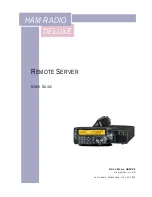
• Remove items from your shirt pocket, such as pens and pencils, that could fall into the server as you
lean over it.
• Avoid dropping any metallic objects, such as paper clips, hairpins, and screws, into the server.
Handling static-sensitive devices
Use this information to handle static-sensitive devices.
Attention:
Static electricity can damage the server and other electronic devices. To avoid damage, keep
static-sensitive devices in their static-protective packages until you are ready to install them.
To reduce the possibility of damage from electrostatic discharge, observe the following precautions:
• Limit your movement. Movement can cause static electricity to build up around you.
• The use of a grounding system is recommended. For example, wear an electrostatic-discharge wrist
strap, if one is available. Always use an electrostatic-discharge wrist strap or other grounding system
when working inside the server with the power on.
• Handle the device carefully, holding it by its edges or its frame.
• Do not touch solder joints, pins, or exposed circuitry.
• Do not leave the device where others can handle and damage it.
• While the device is still in its static-protective package, touch it to an unpainted metal surface on the
outside of the server for at least two seconds. This drains static electricity from the package and from
your body.
• Remove the device from its package and install it directly into the server without setting down the device.
If it is necessary to set down the device, put it back into its static-protective package. Do not place the
device on the server cover or on a metal surface.
• Take additional care when handling devices during cold weather. Heating reduces indoor humidity
and increases static electricity.
Updating the server configuration
When you start the server for the first time after you add or remove a device, you might receive a message
that the configuration has changed. The Setup Utility starts automatically so that you can save the new
configuration settings.
Some optional devices have device drivers that you must install. For information about installing device
drivers, see the documentation that comes with each device.
If the server has an optional RAID adapter and you have installed or removed a hard disk drive, see the
documentation that comes with the RAID adapter for information about reconfiguring the disk arrays.
For information about configuring the integrated Gigabit Ethernet controller, see “Configuring the Ethernet
controller” on page 45.
Instructions for Business Partners
This section contains instructions for Business Partners.
1. After you have confirmed that the server starts correctly and recognizes the newly installed devices and
that no error LEDs are lit, run the Dynamic System Analysis (DSA) stress test. For information about
using DSA, see “Dynamic System Analysis” on page 67.
2. Shut down and restart the server multiple times to ensure that the server is correctly configured and
functions correctly with the newly installed devices.
118
Lenovo System x3550 M5 Installation and Service Guide
Summary of Contents for System x3550 M5
Page 1: ...Lenovo System x3550 M5 Installation and Service Guide Machine Type 8869 ...
Page 6: ...iv Lenovo System x3550 M5 Installation and Service Guide ...
Page 66: ...52 Lenovo System x3550 M5 Installation and Service Guide ...
Page 298: ...284 Lenovo System x3550 M5 Installation and Service Guide ...
Page 1120: ...1106 Lenovo System x3550 M5 Installation and Service Guide ...
Page 1124: ...1110 Lenovo System x3550 M5 Installation and Service Guide ...
Page 1132: ...Taiwan BSMI RoHS declaration 1118 Lenovo System x3550 M5 Installation and Service Guide ...
Page 1134: ...1120 Lenovo System x3550 M5 Installation and Service Guide ...
Page 1142: ...1128 Lenovo System x3550 M5 Installation and Service Guide ...
Page 1143: ......
Page 1144: ......
















































